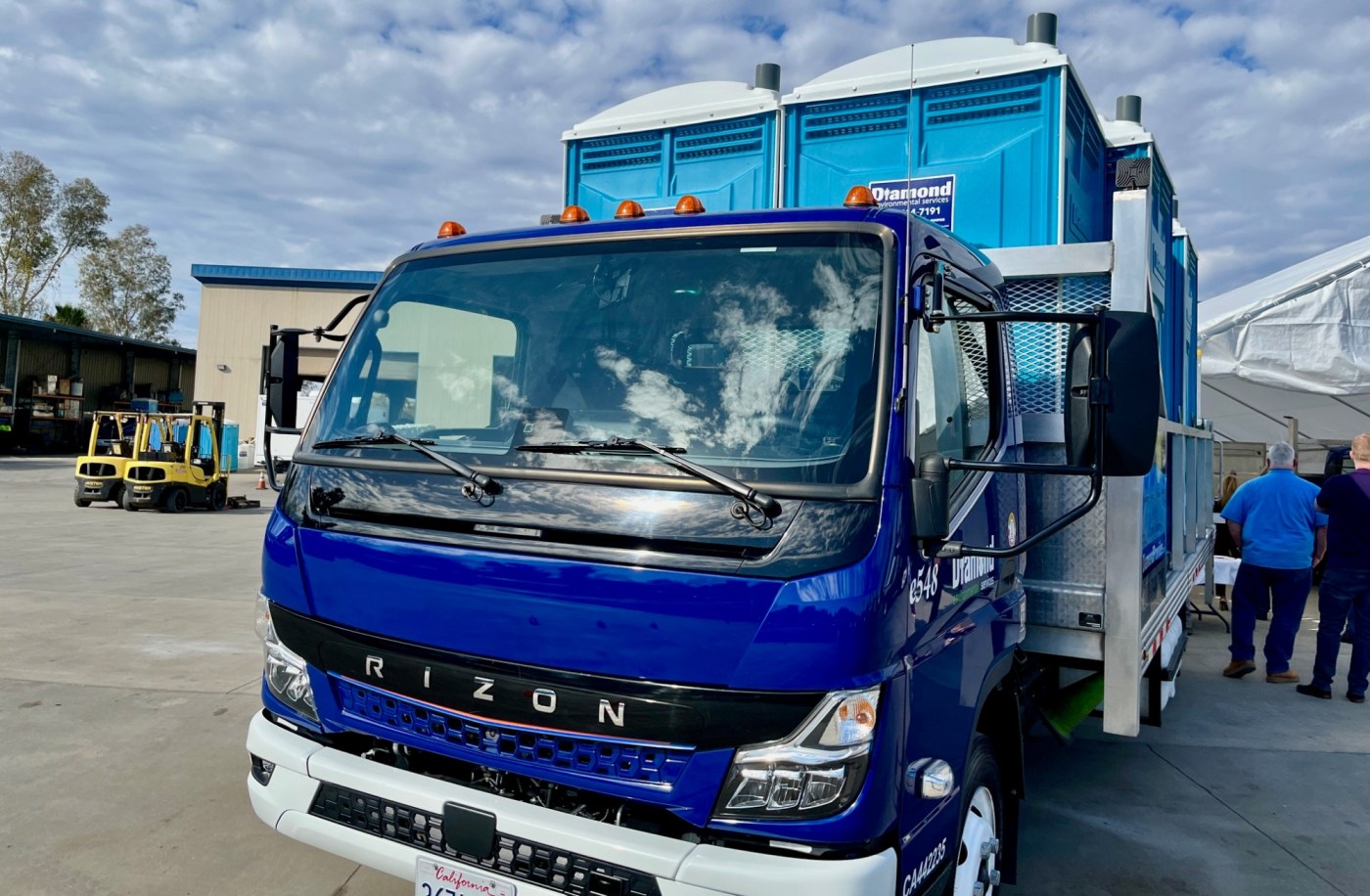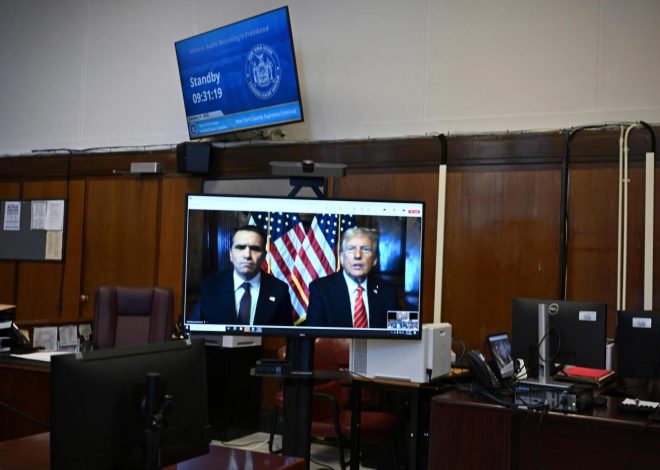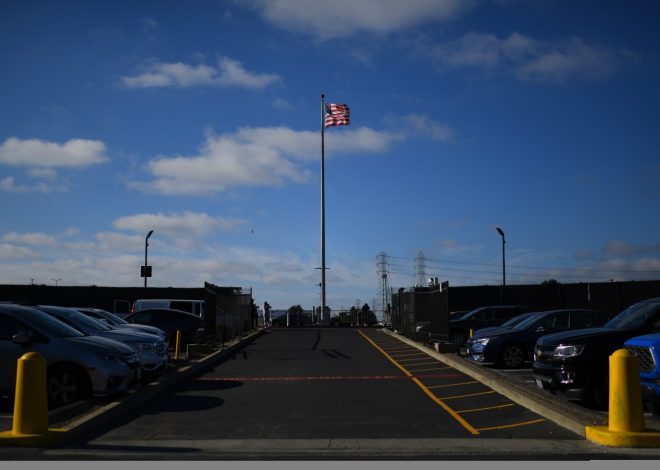
Will California’s zero-emission truck rules work for the long haul?
More companies in the San Diego area that rely on commercial trucks are transitioning to electric vehicles.
But at the same time, some of the business owners making the switch have questions about state mandates that include ending the sales of traditional internal-combustion trucks in the coming years.
Diamond Environmental Services, based in San Marcos, is an example.
The company that provides on-site services and rentals — such as restrooms, sinks, showers, pumping services, dumpsters, port-a-potties and fencing — uses a fleet of 220 trucks to get the job done for its customers across Southern California.
Diamond recently received about $600,000 in state funding from a pilot project to help purchase four new battery-electric, medium-duty trucks. Its sister company that provides water delivery services, called BLu Bulk, bought two all-electric trucks through the program.
“Some of the advantages are that these particular trucks need very little maintenance” compared to diesel trucks in the company’s fleet, said Diamond Environmental Services CEO Alex Fortunati. “We’re intending to purchase more.”
Like other companies across California, Diamond is trying to comply with new state rules.
While many are familiar with Gov. Gavin Newsom’s executive order mandating the elimination of all sales of new gasoline-powered passenger vehicles in the state by 2035, the California Air Resources Board also approved the Advanced Clean Fleets regulation aimed at phasing out sales of new medium- and heavy-duty combustion trucks by 2036.
The regulation adds to California’s Advanced Clean Trucks rule, approved by the Biden administration, which requires manufacturers to accelerate sales of new zero-emissions heavy-duty trucks by 2035. The two rules work in tandem to drastically cut air pollution.
Diamond’s all-electric trucks charge overnight and make their trips throughout the day at customer sites around the county. During lunch breaks, the company’s drivers stop at charging stations to top off the vehicles.
“You’re getting about another 30%” of range during those lunch hours, owner Eric de Jong said. The trucks are used for multiple stops of routes of about 100 miles per day.
But the batteries in electric trucks are heavier than those that use diesel or compressed natural gas so the company currently uses them only for pickup and delivery purposes.
“We’re hoping that through time, the batteries will become less bulky and that the batteries will extend the mileage coverage that is required,” Fortunati said. For now, jobs that require heavier loads — Diamond trucks usually carry about 950 gallons of waste — are still reserved for the other trucks in the company’s fleet.
“The diesel can do everything,” Fortunati said, “and they can go 200 miles, 300 miles.”
The challenge for zero-emission trucks, de Jong says, will be ramping up the technology to the point where the vehicles efficiently operate when carrying a lot of weight for companies that haul things like concrete, garbage and wastewater.
“I do know there’s some success stories on big trucks that are pulling large loads, but they’re hauling (lighter objects like) potato chips — and we don’t haul potato chips,” he said. “We’re here to be part of the solution.”
Alex Fortunati, left, the CEO of Diamond Environmental Services, talks to company owner Eric de Jong in front of one of the Rizon all-electric trucks the San Marcos-based company recently purchased to add to its fleet. (Rob Nikolewski/San Diego Union-Tribune)
The electric trucks Diamond uses are made by Rizon, a division of Daimler trucks, which is the largest commercial vehicle manufacturer in the world.
Rizon specializes in Class 4 and Class 5 medium-duty trucks that use the same chargers used in passenger electric vehicles such as a Tesla or Chevy Bolt.
Alexander Voets, general manager for Rizon Trucks USA, acknowledged there are “growing pains” with the adoption of EVs, including the build-out of charging stations, but expressed confidence that the transition will work.
“The most important thing is just to start it and to do it,” he said. “Just like when you have a gym membership — which gym you go to is not important; going there is important. It’s the same with electric vehicles.”
Eleven states (including California) have adopted the Advanced Clean Trucks rule, known as the ACT for short. But some in the trucking industry want to pump the brakes on the mandates, calling them too aggressive.
Two weeks ago, eight state trucking associations sent a letter to governors in nine different states, asking them to delay implementing the ACT. Among the reasons cited: supply chain issues that have limited the availability of zero-emission trucks and a lack of charging stations along transportation corridors.
“Collectively, we welcome the opportunity to sit down to discuss this situation,” the letter said, “but let us be clear, we are running out of time.”
Related Articles
Opinion: Fewer SJC, OAK passengers is good for climate change fight; Oakland expansion plan is not
Gongloff: Carbon-capture promises require unrealistic land grabs
Once listed for $70 million, controversial private Bay Area island to be auctioned off
East Bay brackish desalination plant set to begin operations
Capitola Wharf survives mother nature’s first big test since reopening
Supporters of the clean truck mandate point to its health benefits.
While trucks represent only 6% of California vehicles, they represent a quarter of the state’s on-road greenhouse gas emissions and more than one-third of the state’s NOx (nitrogen oxides) air pollutant emissions. California officials expect the rule to generate $26.5 billion in health savings.
“California has worked to address feedback from the industry in its regulations and has built in flexibilities that address concerns heard from manufacturers while still meeting the need to reduce emissions,” the Air Resources Board said in an email to the Union-Tribune. “For over 50 years, California has consistently listened to the concerns of industry.”
The $600,000 grant that Diamond Environmental Services received was administered by the San Diego County Air Pollution Control District. The money came from the Air Resources Board and is part of a short-haul, zero-emission pilot project to help clean up the air in communities around the Port of San Diego, an area where Diamond trucks operate.
“This is basically a step in the right direction to improve air quality and reduce emissions in disadvantaged communities and overall the county of San Diego,” said Travis Arciaga, an engineer at the pollution control district. “Instead of these big diesel trucks going through (portside areas), we have an electric truck going through without diesel emissions.”
The Portside Environmental Justice Community encompasses parts of Barrio Logan, Logan Heights, Sherman Heights and National City.


